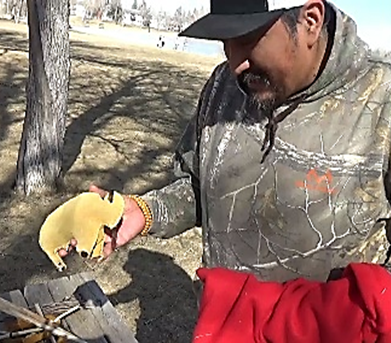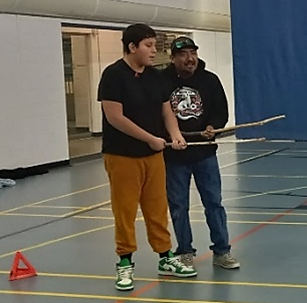Double Ball Game
Double Ball Game - Ist Pokón Iihtá’paisskootsiiyo’p
with Jason Plain Eagle
In the past, Double Ball was played only by women but has since expanded to be played by all groups. The key to playing Double Ball is to transfer it past the opposing team members, either by throwing the ball or running with it, using a stick. Under no circumstances can the ball be touched with the hands [1].
From: Native American Games
The Chippewa used one long piece of buckskin about 18 inches in length to cover two balls at each end. The sticks were around 44 inches in length and painted red. The Cree used two oblong balls covered in buckskin joined together with a buckskin thong to make a double ball with a length of 24 inches. The sticks usually had a curve at the end to catch the double ball [1].
Native American Games: World Atlas
Many Indigenous groups played Double Ball or Nobbies including the Cree, Blackfoot, Inuit, Assiniboine, and Skowkale. Double Ball was played only by women [2]. Depending on the tribe, some women would wear very little; some with only a short skirt to play in [1]. As a sign of respect, women played without men able to watch them play as women were the community’s life givers [2].
The game is similar to lacrosse, such that there are two goals, one at each end of a long field, (~1 mile) and there are various players stationed around their team’s side of the goal area. The goals consisted of high poles spaced apart around 10 feet, often having a long stick across bundles at the top [2, 3].
The game began with players gathered around the center of the field and the double ball thrown into the center of the playing field [1]. Once the double ball falls to the center, players use their sticks to wrap the ball and work their way across the field to throw through the opponent’s goal area. The game Double Ball usually involved stakes of some sort as games were a large part of trading or settling disputes among tribes [1, 3].
The primary rules were: all players must have their own sticks and must not hit other players. They can only be used for checking the ball and picking the ball up to run to the goal [3].
“When I was taught how to make the sticks for Double ball, I take measurements by placing the sticks on my hip and extend the stick to a 45-degree angle. The end of the stick will be where my hand is extended. I then measure with my hands, three hands up from the base of my stick will be the handle [4].
The double ball is made from buffalo hide and stuffed with buffalo hair. I also have a couple of leather pouches inside filled with sand. Traditionally, threading would be sinew from the buffalo, but this one has synthetic thread [4].”
Jaron Weasel Bear
“The game Double Ball can be played with teams up to two tribes; 40, 60, or 80 players. You can play with two goals at each end of the field. These sticks, goal posts, standing in the ground will have tripods on the top of each stick to hold another stick across and joining each goal stand. Goals are scored as two points if the double ball is thrown over the goal, one point if the ball is thrown under the goal and three points if the ball is wrapped over the stick joining the goal posts [4].”
Jason Plain Eagle tells us of a modern-day game using traditionally made game equipment: “Another way to play is with this stuffed buffalo [4].”
Jason has adapted the original aspects of the game to use a different approach when playing in an indoor gym. Instead of having two goals posted at each end of the gym, he placed pylons at each end to represent the ends of the playing field.
Double Ball Game Ist Pokón Iihtá’paisskootsiiyo’p
Firstly, teams warm up with a hand-eye coordination game of Ring the Stick where players try to put a stick through a ring attached to the end of the stick.
The game begins with players forming a tipi with their sticks at the center of the court. The referee then throws the double ball into the center where players attempt to stick it and run with the double ball to obtain a goal.
“Each player carrying the double ball has to run around the pylon on the opposing team’s side, come back and displace the buffalo placed in the center of the court in order to score [4].”
“A score is made when the stuffed buffalo is knock it over. If a player kicks or steps on it, it’s a point for the other team. If you knock it with your feet, it’s a point for the other team. Remember who are the protectors of your team to protect this buffalo. There will be no slashing, no checking, no kicking [4].”
“When playing outdoors, I always teach the players it’s very important to be mindful of your foot work and your surroundings. When playing outside you need to be aware of gopher holes, rocks, and the trees. You don’t want your ball to get stuck up in the tree [4].”
“When I work with a group I always watch the children’s behavior and skills, which children are having difficulty and which ones are natural leaders. I include all children/youth in our games. Some may be fast and hyperactive [4].”
I try to work one-on-one with those children and keep them moving, maybe they’ll be a good referee and can be captains of their team. Some children are lethargic and tired; those could be goalies or defensemen [4].”
“Whenever I play these games with youth and children I aways try to instill positivity, culture, language, land-based teachings, and Creation stories. I always try to instill respect. Respect for your persons, respect for your peers, and respect for everybody (Plain Eagle, 2024).”
References
1. Stewart, C. (1992). Games of the North American Indians, V2: Games of Skill. (pg.561, 651, 652). University of Nebraska Press: Lincoln, Nebraska, U.S.A.
2. James, M. (2024). Indigenous Games for Children. From Indigenous Communities Across Canada. Retrieved online from EA_indigenous-games-for-children-en.pdf (csf.bc.ca) March 2024.
3. We R Native (2024). Retrieved online from Double Ball - We R Native March 2024.
4. Plain Eagle, J. (2024). In discussion. March, 2024.









